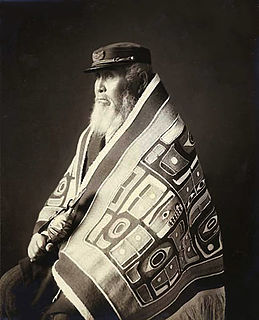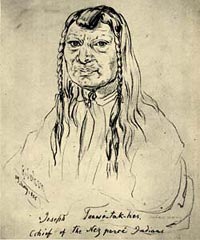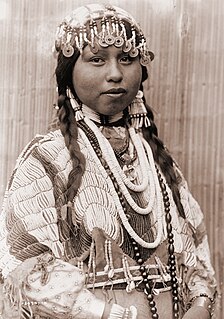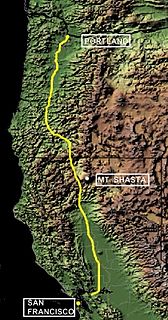 W
WThe Cascades Rapids were an area of rapids along North America's Columbia River, between the U.S. states of Washington and Oregon. Through a stretch approximately 150 yards (140 m) wide, the river dropped about 40 feet (12 m) in 2 miles (3.2 km). These rapids or cascades, along with the many cascades along the Columbia River Gorge in this area of Oregon and Washington, gave rise to the name for the surrounding mountains: the Cascade Range.
 W
WCelilo Village, Oregon is an unincorporated Native American community on the Columbia River in northeastern Wasco County in the U.S. state of Oregon. It is near Lake Celilo, the former site of Celilo Falls; it is just south of the community of Wishram, Washington, across the Columbia River.
 W
WChemawa Indian School is a Native American boarding school in Salem, Oregon, United States. Named after the Chemawa band of the Kalapuya people of the Willamette Valley, it opened on February 25, 1880 as an elementary school. Grades were added and dropped, and it became a fully accredited high school in 1927, when lower grades were dropped. In 2005, it continued to serve ninth through twelfth grades. It is sometimes referred to as Chemawa High School. It has primarily served students of tribes from the Pacific Northwest and Alaska.
 W
WHenry Roe Cloud was a Ho-Chunk Native American, enrolled in the Winnebago Tribe of Nebraska, who served as an educator, college administrator, U.S. federal government official, Presbyterian minister, and reformer.
 W
WComcomly was a leader of the Lower Chinook people located near the present day city of Ilwaco, Washington. Referred to as "Chief" or "'King", a derogatory term, Comcomly in contemporaneous journals,
 W
WAnson G. Henry was a physician and politician, who is best known for his friendship with eventual President Abraham Lincoln. Henry received patronage appointments to Oregon Territory through Lincoln from 1852 onwards, first as an Indian agent and then as Surveyor General of Washington Territory. He died when the steamer Brother Jonathan ran aground near Crescent City, California and sank.
 W
WThe Indian Shaker Church and Gulick Homestead are an ensemble of historic buildings in The Dalles, Oregon, United States. Built by Henry Gulick directly on the Columbia riverbank in the 1890s, it is the only remaining 19th century fishing homestead in Oregon. Gulick, an employee of the locally-important Seufert salmon canning concern, included a church building in the complex in ca. 1896 for his wife, Harriet, a member of the Wasco people. The church was the smallest of five Indian Shaker Church congregations in the state.
 W
WThe Indigenous peoples of the Pacific Northwest Coast are composed of many nations and tribal affiliations, each with distinctive cultural and political identities, but they share certain beIiefs, traditions and practices, such as the centrality of salmon as a resource and spiritual symbol, and many cultivation and subsistence practices. The term Northwest Coast or North West Coast is used in anthropology to refer to the groups of Indigenous people residing along the coast of what is now called British Columbia, Washington state, parts of Alaska, Oregon, and Northern California. The term Pacific Northwest is largely used in the American context.
 W
WHin-mah-too-yah-lat-kekt, popularly known as Chief Joseph, Young Joseph, or Joseph the Younger, was a leader of the Wal-lam-wat-kain (Wallowa) band of Nez Perce, a Native American tribe of the interior Pacific Northwest region of the United States, in the latter half of the 19th century. He succeeded his father Tuekakas in the early 1870s.
 W
WTuekakas, commonly known as Old Chief Joseph or Joseph the Elder, was a Native American leader of the Wallowa Band of the Nez Perce. Old Joseph was one of the first Nez Percé converts to Christianity and a vigorous advocate of the tribe's early peace with whites. In 1855 he aided Washington's territorial governor and set up a Nez Percé reservation that expanded from Oregon into Idaho. The Nez Perce agreed to give up a section of their tribal lands in return for an assurance whites would not intrude upon the sacred Wallowa Valley.
 W
WKalapuyan is a small extinct language family that was spoken in the Willamette Valley of Western Oregon, United States. It consists of three languages.
 W
WThe Malheur Indian Reservation was an Indian reservation established for the Northern Paiute in eastern Oregon and northern Nevada from 1872 to 1879. The federal government "discontinued" the reservation after the Bannock War of 1878, under pressure from European-American settlers who wanted the land, a negative recommendation against continuing it by its agent William V. Rinehart, the internment of more than 500 Paiute on the Yakama Indian Reservation, and reluctance of the Bannock and Paiute to return to the lands after the war.
 W
WThe Native American peoples of Oregon are the set of Indigenous peoples who have inhabited or who still inhabit the area delineated in today's state of Oregon in the Pacific Northwest region of the United States. While the state of Oregon currently maintains relations with nine federally recognized tribal groups, the state was previously home to a much larger number of autonomous tribal groups, which today either no longer exist or have been absorbed into these larger confederated entities.
 W
WThe Nez Perce War was an armed conflict that pitted several bands of the Nez Perce tribe of Native Americans and their allies, a small band of the Palouse tribe led by Red Echo (Hahtalekin) and Bald Head, against the United States Army. The conflict, fought between June and October 1877, stemmed from the refusal of several bands of the Nez Perce, dubbed "non-treaty Indians," to give up their ancestral lands in the Pacific Northwest and move to an Indian reservation in Idaho. This forced removal was in violation of the 1855 Treaty of Walla Walla, which granted the tribe 7.5 million acres in their ancestral lands and the right to hunt and fish in lands ceded to the government.
 W
WThe Siletz Agency Site, also known as Government Hill, is a historic site and park located in Siletz, Oregon, United States. Beginning in 1855, U.S. Army forcibly relocated over 2,600 people of several different tribes to the Siletz Reservation. The U.S. government established an Indian agency at Siletz in 1857. Within 30 years, hardship had reduced the Indian numbers to approximately 600. By the time the agency closed in 1925, it had grown to include a blockhouse, boarding house, schoolhouse, barn, office building, several employee residences, hospital/meeting house, and cemetery, several of which have since been destroyed.
 W
WThe Siskiyou Trail stretched from California's Central Valley to Oregon's Willamette Valley; modern-day Interstate 5 follows this pioneer path. Originally based on existing Native American foot trails winding their way through river valleys, the Siskiyou Trail provided the shortest practical travel path between early settlements in California and Oregon.
 W
WSnake Indians is a collective name given to the Northern Paiute, Bannock, and Shoshone Native American tribes.
 W
WTable Rock Reservation was a short-lived Indian reservation north of the Rogue River in Oregon, United States. It was established by treaty with the Rogue River Indians in 1853. Following the conclusion of the Rogue River Wars in 1856, the Native American inhabitants were moved to other reservations. The reservation was in Southern Oregon, between Upper Table Rock and Evans Creek.
 W
WThe Treaty with the Kalapuya, etc., also known as the Kalapuya Treaty or the Treaty of Dayton, was an 1855 treaty between the United States and the bands of the Kalapuya tribe, the Molala tribe, the Clackamas, and several others in the Oregon Territory. In it the tribes agreed to cede land in exchange for money. The treaty effectively gave over the entirety of the Willamette Valley to the United States and removed Native Americans in the area. The treaty was signed on January 22, 1855, in Dayton, Oregon, ratified on March 3, 1855, and proclaimed on April 10, 1855.
 W
WUpper Table Rock and Lower Table Rock are two prominent volcanic plateaus located just north of the Rogue River in Jackson County, Oregon, U.S. Created by an andesitic lava flow approximately seven million years ago and shaped by erosion, they now stand about 800 feet (240 m) above the surrounding Rogue Valley. The Table Rocks are jointly owned; The Nature Conservancy is responsible for 3,591 acres (1,453 ha), while the Bureau of Land Management is responsible for 1,280 acres (520 ha).
 W
WYellow Wolf or He–Mene Mox Mox was a Nez Perce warrior who fought in the Nez Perce War of 1877. In his old age, he decided to give the war a Native American perspective. From their meeting in 1907 till his death in 1935, Yellow Wolf talked annually to Lucullus Virgil McWhorter, who wrote a book for him, Yellow Wolf: His Own Story. He is notable as one of the few members of the defeated Nez Perce to talk openly to strangers and tell their story to the world.